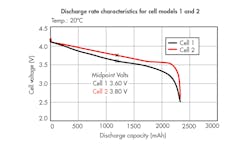Download this article in PDF format.
When trying to decide on the right battery cell for a mobile-device application, designers must sift through the differentiating features between these cells—as well as be keenly aware of their shortcomings. Another issue that’s carrying more weight these days is the continuance of cell supplies to the industry.
For instance, due to the predicted growth in electric vehicles (EVs), cell manufacturers are dedicating much of their production to this emerging new market and are allocating fewer cells to the mobile-device markets. A recent article in the Wall Street Journal stated that more than 40 Tesla-sized “Giga-factories” would be required to meet the anticipated demand of the EV market. This puts new pressures on mobile-device and battery-pack designers—especially on smaller volume projects.
To gain a competitive edge in this mobile-device battery space, it’s important to thoroughly consider the entire battery design and apply proper techniques during the development process. Just making minute tweaks in cells used, battery-assembly components, and assembly techniques can enhance overall device performance and end-user productivity.
Also, be sure that the battery cell you choose will be available during the estimated service life of your device. Keep in mind that you will likely be providing replacement battery packs and chargers for many years.
A high-performance—yet safe—battery has become paramount, especially in light of today’s high-energy lithium chemistries. Thus, its design should be predicated on four main building blocks:
- A safe cell with optimal price/performance balance.
- A cell that will be available for the life of the mobile device it powers—now more important than ever.
- A properly designed battery-management system (BMS) or safety circuitry electronics.
- Battery-pack construction and internal materials.
Cell 2 is better suited to provide more capacity to applications with higher voltage.
Follow These Steps
Match Up the Specs
Perhaps the most critical consideration is to select a cell that properly matches the application. Choosing the correct cell is more than just about its overall form factor and cost. Differences in device run time and reliability under various operating conditions must also be carefully analyzed. Temperature extremes of the usage environment, charge and discharge regimes required by the device, internal cell impedance, and operating voltage profile of the cell also must be reviewed carefully to match device and user specifications.
Consider a Top-Tier Manufacturer
With the vast array of cell manufacturers and cell models out there, it can become quite the challenge to find a cell that correctly matches your device application. Often, the most pragmatic approach is to start with a top-tier cell manufacturer. Then get the following information:
- The cell safety certification per UL 1642/UL62133.
- The “UL yellow card” indicating that the cell was properly tested.
- A certificate showing that testing was performed for safe shipping of the product per UN 38.3.
If this documentation isn’t available, steer away quickly. Top-tier cell manufacturers should be able to readily supply these documents.
Safety First
Cell performance should always be considered secondary to safety. Careful review of the cell specifications may highlight deficiency areas within some products that don’t match the application.
Ask questions to sort out differences in cell-performance characteristics:
- How is the mobile device charged, and what are the temperature extremes during charge?
- Can the cell sustain discharge at the lower temperature extremes?
- How does cell life factor into the overall usage regime?
- How does the internal impedance affect overall discharge efficiencies?
- Does the cell’s discharge voltage profile match the device’s operating-voltage levels for maximum capacity and runtime gains?
Li-ion or Li Polymer?
Another important question regarding the cell is whether to use traditional lithium-ion (enclosed in metal cans) or the newer generation lithium-polymer (enclosed in a foil pouch) products. Each product has its own benefits and shortcomings in performance, durability, safety, and choice of sizes. Although either is acceptable from a power standpoint, there are many tradeoffs. Advantages of Li-ion include:
- Traditional Li-ion cells are the most rugged and have the highest “acceptance of abuse” from the user. High-end, ruggedized applications are best served with these types of cells.
- Their metal-can construction provides the greatest protection against impact and shock resistance, as well as puncture by foreign objects. It unitizes the cell construction within the battery assembly while having the highest power density to weight and volume.
Lithium-polymer cells come with important advantages, and one main disadvantage:
- Advantage: Lighter weight.
- Advantage: More easily configurable for specific pack sizes and can fit into irregular shapes.
- Disadvantage: Due to their foil-pouch configuration, these cells aren’t as ruggedized, and they can’t pass some of the UL 1642 safety testing. Therefore, pack designs must be modified to adapt.
Consider carefully the proper cell-construction differences, whether traditional lithium-ion or lithium polymer, to assure your end product meets the intended usage.
Capacity and Lifetime
Overall cell-capacity differences must be reviewed to assure it meets the device needs in terms of capacity, voltage, and current delivery. Although usually specified to the same ANSI rating and overall testing, vast differences emerge under operating conditions. It’s important to review the manufacturer’s data, but also perform lab testing with various cell models to fully understand discharge differences.
Confirming that the cell you choose will be available during the estimated service life of your device is important. Proper cell selection will limit the design changes you may face down the road as that particular product goes end of life (EOL).
Understanding all these possible scenarios may help avoid costly design changes later, and make your mobile device available for its intended lifetime. And addressing all of these issues will help protect against premature cell EOL and provide important sustainable competitive advantages.
About the Author
Danny Rockett
VP of Manufacturing and Technology
Danny Rockett leads the GTS technical and manufacturing teams as Vice President of Manufacturing and Technology. He has more than 35 years of battery experience in a variety of assignments and responsibilities with General Electric, Gates Energy, Energizer, Nexergy/ICC and GTS. His expertise in batteries covers OEM and aftermarket products for consumer, industrial, enterprise, and public-safety markets. Danny holds three U.S. patents and has published a variety of articles within the battery industry for trade magazines.


